Bonsai is a reproduction of the forms of a natural tree in miniature. This art form originates in Japan and China, where it has been practiced for centuries. We will talk about how to grow a lilac bonsai tree at home using the Meyer lilac as an example.
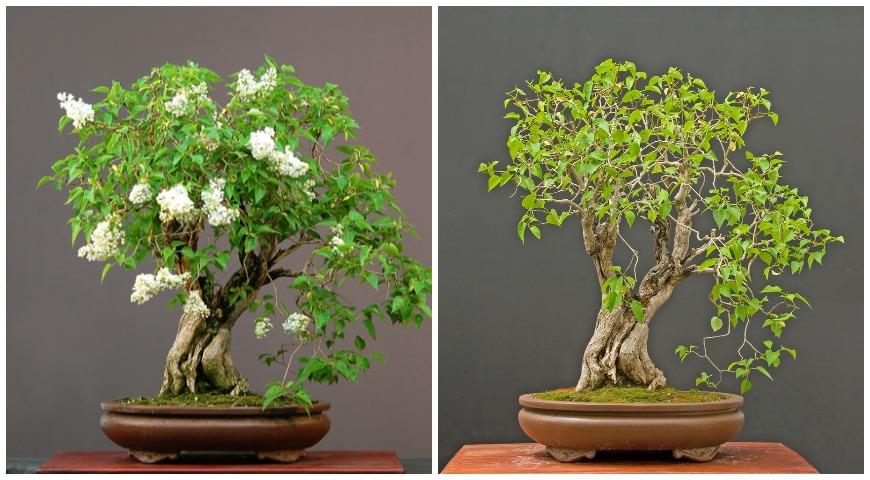
(How to Grow a Lilac Bonsai Tree 2022,Bonsai Tree,Lilac Bonsai Tree,How to Grow bonsai tree)
Aesthetics of the Lilac Bonsai Tree
Lilac is rarely used in Japanese bonsai, and outside of Japan as well. For the first time I saw a lilac in the form of a bonsai at the famous German bonsai master Walter Poll, who lives near Munich. After the unification of the two Germanys, he received several adult lilac bushes from one of the nurseries near Berlin and formed a bonsai from them. And although their crown looked somewhat chaotic, such is the naturalistic style of Walter's formation.
In 2005, the famous Japanese master Nabiuchi Urushibata presented a small tree of an unknown species to me. When the buds appeared and opened, I could unmistakably - by smell - determine that it was lilac. After that, the definition of Meyer's species was no longer difficult. Given its small size, the tree quickly acquired a finished look.
This type of lilac is ideal for bonsai: for the proportionality of the image, it is best to use trees and shrubs with small flowers or inflorescences. It is also desirable that the starting material has a medium-sized leaf and short internodes. Although these characteristics can be changed in the right direction with the help of some cultural practices, for Meyer lilacs they are not particularly necessary.
Bonsai, even of small size, usually require a certain thickness of the trunk to resemble a mature tree in nature, the height of the tree should be related to the thickness of the trunk at the base (in Japanese - nebari) in a ratio of 6:1. Say, with a height of 21 cm, the diameter of the nebari should be at least 3.5 cm.
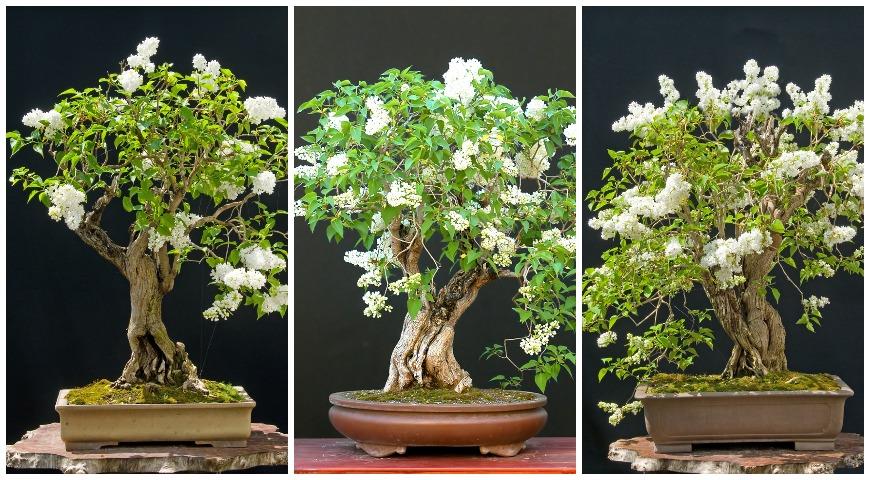
The preparatory stage for growing lilac bonsai
I purchased a seedling of such a lilac in the garden center and planted it in my garden “for overclocking”. For about 5 years, the lilac grew in the ground without my intervention, with the exception of the periodic cutting of the bush along the perimeter of the crown to thicken it. I initially chose a bush with a curved base of the trunk, which over the years has acquired not only greater thickness, but also some texture, which is very much appreciated in bonsai, because it reflects the impact of the forces of nature on the tree.
In the spring, I transplanted it into a training container to start the most interesting thing - the process of forming a bonsai. However, after transplanting, it was necessary to allow the tree to grow quietly for at least one season in order to restore the root system.
The next year, I was faced with a dilemma - just cut off all the excess, as Michelangelo "recommended", or try to put air layers on those large branches that would not be useful in tree design, so that they could be used again as planting material.
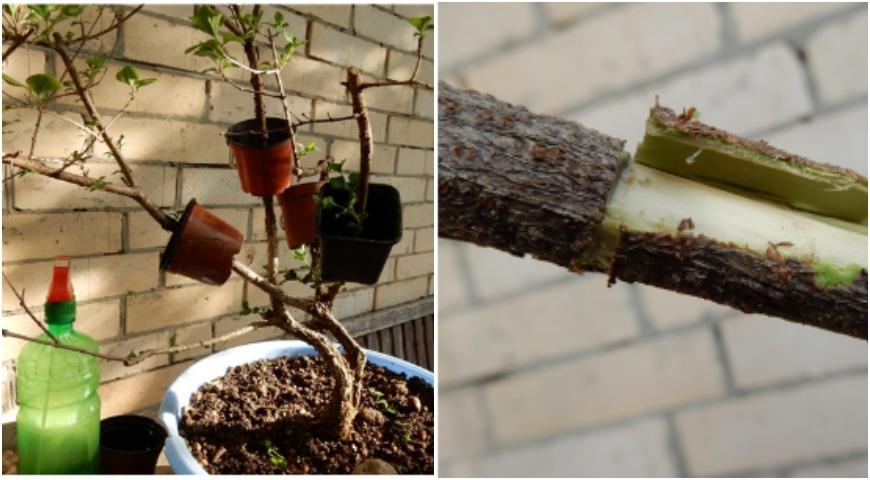
In the photo: Removing a strip of bark for air layering; Air layers placed on all “unnecessary” shoots (Author: Darusenkov A.O.)
In the case of deciduous trees and shrubs, two to three months is usually sufficient for the formation of a new root system. However, in this case, the layering did not work, and the branches on which they were made dried up. The dead branches had to be removed, leaving the bases from which the so-called dzins were formed - i.e. dead branches that give bonsai an extra charm or that very “sabi” - a touch of antiquity.
General rules for the formation of a bonsai tree
The first thing to do is to shorten the trunk as much as possible in early spring, leaving only the part of it that is needed for the future design of the tree. It's good when there is a vertically growing branch that can become a new crown - the trunk above this branch can simply be cut off. If there is no such branch, you need to cut the trunk a little higher. Radical pruning, as a rule, serves as an impetus for awakening dormant buds along the entire trunk, from which new shoots grow. A year later, you can choose a new leader and skeletal branches of the future bonsai from them, and delete the rest.
However, if some parts of the trunk need further thickening, then it makes sense to leave the maximum number of branches in this place, let them grow and “work” to thicken this particular section of the trunk. When the trunk reaches the desired thickness, these "sacrificial" branches can be cut. It also makes sense to temporarily leave as many shoots as possible around large cuts, as they contribute to their faster tightening.
In the process of creating a bonsai, it is very important to decide on the general style or image of a tree and its face - the most beautiful, winning side, from which the base of the trunk (nebari) looks best, as well as its most interesting bends. To do this, the workpiece is rotated to inspect from all sides, while tilting in different directions. Sometimes, as a result, the tree takes on a very unexpected shape. In my case, this is what happened. In this generally upright blank, I saw something cascading, and with the help of trimming and wire laying, I gave it a semi-cascading shape and transplanted it into an unusual container, more suitable for coniferous trees.
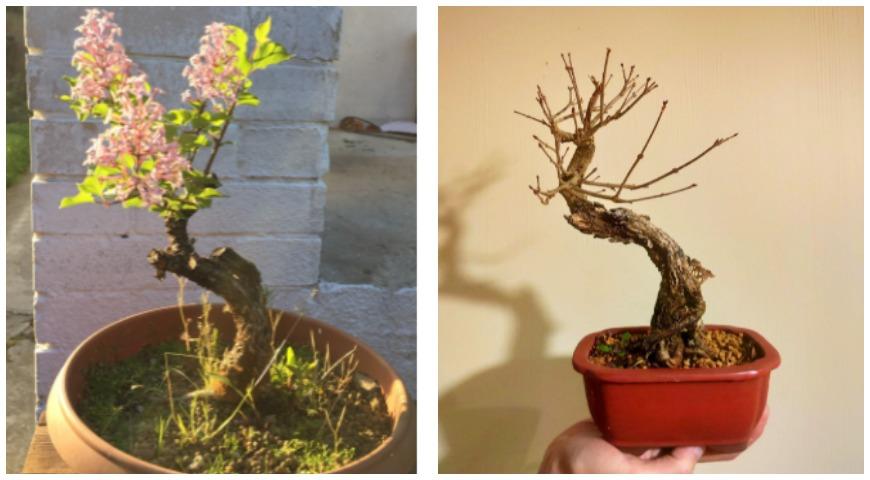
In the photo: Lilac in a training container after a radical pruning of the main branches; Lilac in a bright container (Author: Darusenkov A.O.)
Lilac bonsai formation
Pruning and shaping with wire is best done in early spring, before bud break. After pruning, wire can be applied to the main skeletal branches to give them the desired position, direction and shape. As a rule, deciduous trees and shrubs grow and get fat rather quickly, so you need to regularly monitor if the wire has begun to cut into the bark. If this happens, you must immediately remove the wire and wind it again, but in a different place, not in the traces of its original winding.
In response to this formation, the lilac showed me its dislike for the wire. Most of the wire-wrapped branches withered away, although the lilacs wintered in an underground shelter with a temperature just above zero. After that, I had no choice but to return it to an upright position, in which it is more natural for a tree to grow a new crown.
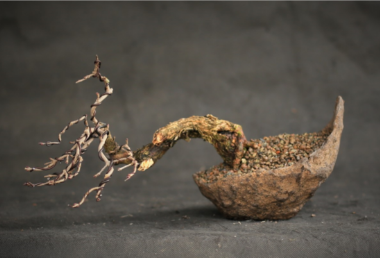
In the photo: lilac in a semi-cascade style (Author: Darusenkov A.O.)
Choosing a Bonsai Container
For such an informal vertical style (moyogi), a bright red container of greater depth was very suitable. Since beautifully flowering trees and shrubs spend a lot of energy on flowering, they require more voluminous dishes as bonsai. And the decorative nature of the composition justifies such a bright, not at all strict container. Sometimes bonsai lovers underestimate the importance of dishes in the composition, but in vain. After all, properly selected ceramic utensils play here approximately the same role as a frame in painting, about which the classic of Russian realism I. Repin spoke like this: “Without it, a picture is like a general in a bath.”
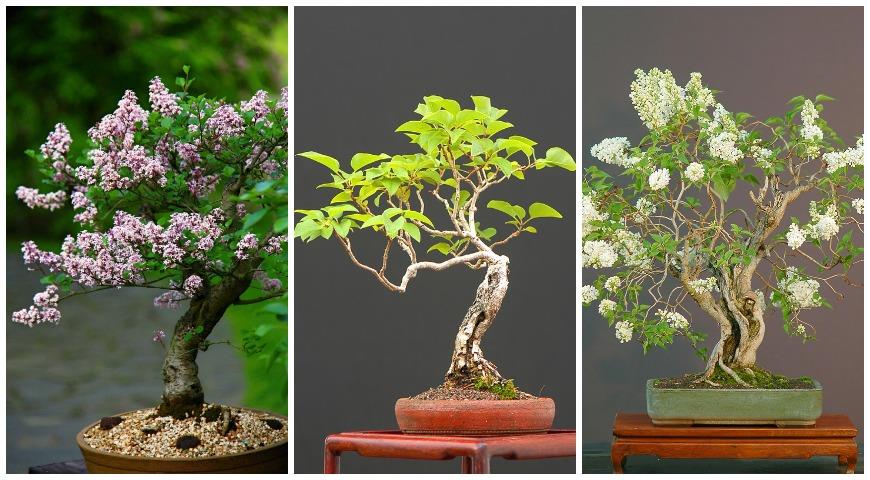
A mixture of diatomite (a porous natural mineral) with a fraction of 3-5 mm and coco peat in a ratio of 2:1 was used as a substrate. This mixture allows for a good balance of water and oxygen, as it retains some moisture, shedding excess moisture, and contains enough oxygen for root growth. The drainage holes were covered with a special mesh with a mesh size of 2 mm, and the tree was fixed in the pot with a wire threaded through these holes.
Given the bad experience with wire, in the future, I suppose to form the crown mainly by trimming.
How to properly care for Lilac bonsai
Bonsai are grown in pots and the longevity of the plants depends entirely on your care. With proper care, your bonsai will remain healthy, beautiful and miniature for years to come. Because your lilac bonsai is a living miniature tree that will become more and more beautiful over the years.
Winter maintenance Lilac bonsai
The lilac bonsai is a living miniature tree, not a houseplant, so should be kept cool during the winter season. This can be achieved in several ways. One way is to bury the tree in the ground (preferably without a pot) to the edge of the container and then mulch to the first branch. For wintering, choose a place protected from wind and sun, without spring flooding.
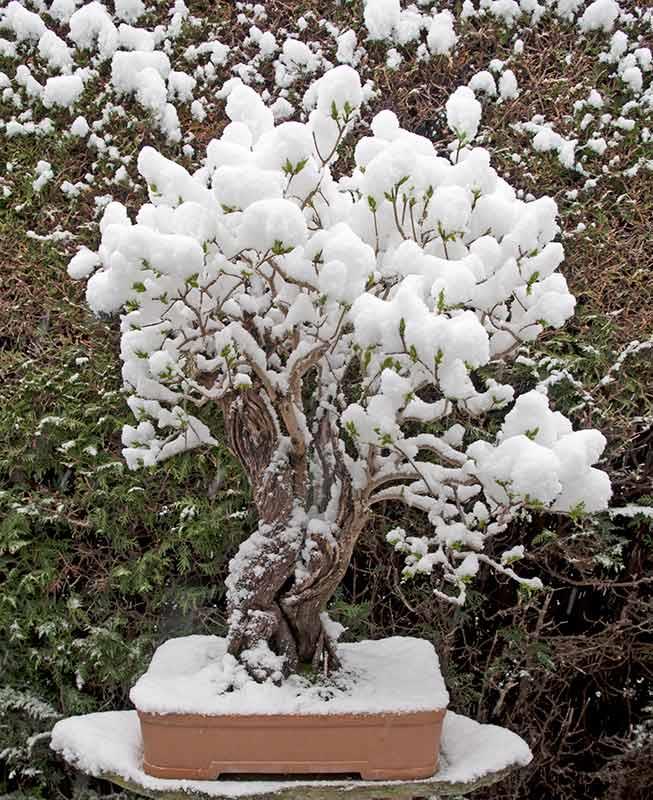
The second common method is to place the tree in an unheated garage or shed. At this time, your tree does not need light because it is in a dormant state; however, it will need to be watered approximately every two weeks.
In spring, summer, and autumn, bonsai should be placed outdoors, such as on a patio, balcony, terrace, or garden, where it will receive sufficient sunlight - morning sun and afternoon shade are best. I practice placement from the end of March/beginning of April to the end of October/beginning of November in the garden on a table in a sunny place, and in winter in an underground shelter (cellar) without light.
Watering Lilac bonsai
Water as the soil dries out - never let the soil dry out completely. If your bonsai is under sunlight, it may need to be watered once a day. This schedule may vary depending on pot size, soil type. It is recommended to use a moisture meter until you know the requirements of your bonsai tree. Watering should be done with a watering can or hose attachment, which should deliver water gently enough to not disturb the soil. Water should be poured until it starts to flow out of the holes in the bottom of the container. I water with settled well water as the top layer of soil dries out (in winter, in a wet cellar, watering is not necessary, sometimes once a winter I can put snow on the surface of the substrate to ensure its gradual moistening).
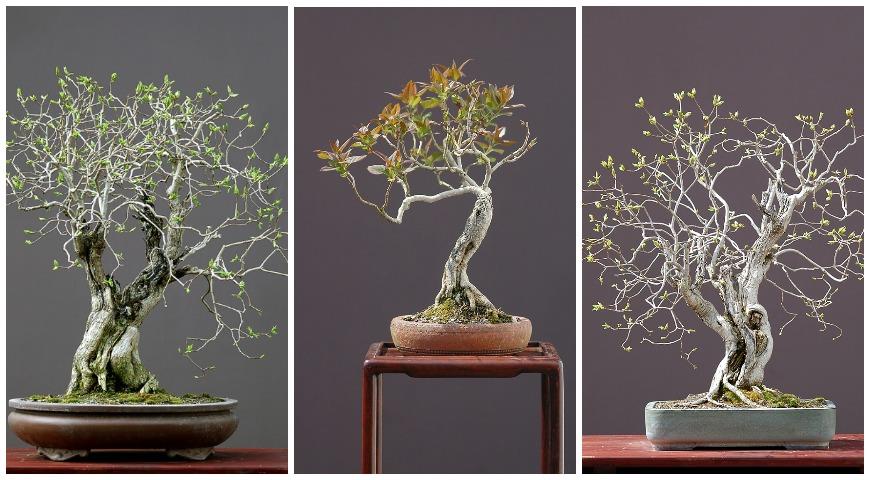
Fertilizers for bonsai
Since bonsai grows in a limited amount of soil, it is necessary to periodically replenish nutrient stores. Any general purpose liquid fertilizer available at most garden centers will work. In this case, we recommend using fertilizers half the recommended concentration.
I fertilize with dry organic fertilizer Organic Mix twice a season and liquid organic fertilizer diluted in water every 10-14 days, the latter I start using after flowering is over.
Fertilizer should be applied at least once a month, break in winter. Your bonsai will also respond well to a foliar spray every two months.
Trimming and pinching bonsai
Pruning and pinching will keep the tree small. Never remove all new shoots, leave a little to keep the tree healthy. Because different trees grow at different rates, experts can help you adjust pruning and pinching.
Bonsai transplant
It depends on how fast your lilac grows and when the root system fills the entire pot. Transplanting is needed to provide your tree with fresh soil and promote a more compact root system.
Transplantation is carried out in the middle of summer. The tree, together with all the soil, should be removed from the pot, the lower and outer part of the root mass of the tree should be removed by a quarter. The tree can then be placed back into the original pot or into a new one. The pot should have a mesh over the drainage holes. Then a thin layer of fine gravel is laid on the bottom of the drainage pot. New fresh soil is placed on top of this gravel. Lay down a layer of well-drained soil, enough to raise the tree to its original height in the pot. After placing the tree in a pot, the area left free from the cut root mass should be covered with fresh soil so as not to leave air pockets. Bonsai should be watered thoroughly after transplanting.
Insects and diseases
Bonsai can be treated for insects and disease just like any other tree. I do not carry out preventive treatments with insecticides and fungicides, and I prefer prevention to combat pests and diseases, the main element of which is to strengthen the health of trees by creating optimal conditions for them.
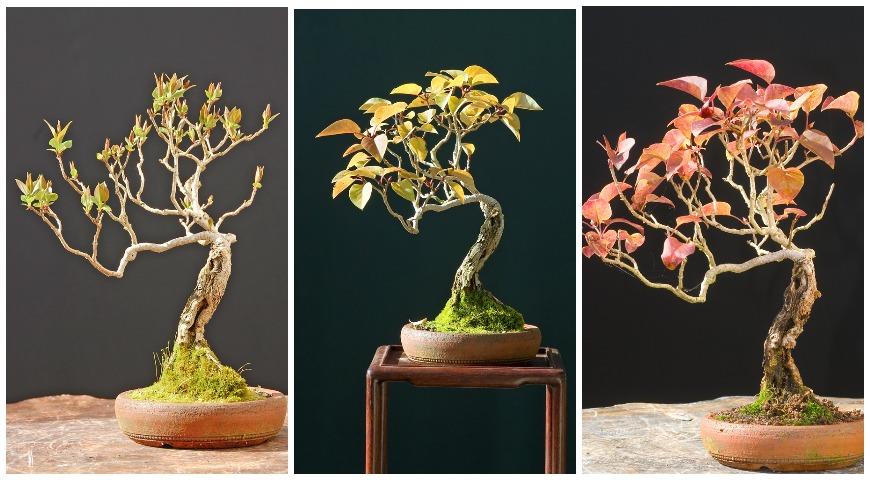

.jpeg)


0 Comments
Post a Comment